
Burevestnik: a Russian air-launched anti-satellite systemby Bart Hendrickx
|
| Most likely, the rocket will not carry a kinetic kill vehicle like its Soviet-era predecessor, but will serve as a launch vehicle for small interceptor satellites that can approach and disable enemy satellites. |
So it looked like the new project could well be a reincarnation of Kontakt, as was speculated in many articles in the weeks following the release of the pictures. Backing up that idea were at least two statements made by Russian officials. In August 2009, the commander-in-chief of the Russian Air Force, Aleksandr Zelin, had declared that the MiG-31 was being upgraded to perform the same space defense tasks as in the Soviet days. About eight years later, in February 2017, a squadron commander of the Russian Aerospace Forces, Yevgeny Polyakov, was quoted as saying by the Russian Ministry of Defense’s Zvezda TV channel that a new missile was being developed for the MiG-31BM “capable of destroying targets in near-space.”
Analysis of publicly accessible online Russian sources now leaves little doubt that the MiG-31BM and the rocket are part of a broader ASAT project called Burevestnik (“Stormy Petrel”). Most likely, the rocket will not carry a kinetic kill vehicle like its Soviet-era predecessor, but will serve as a launch vehicle for small interceptor satellites that can approach and disable enemy satellites.
Burevestnik, a popular name in Russian culture, was also the name given by popular vote to a nuclear-powered cruise missile (9M730) not long after it was unveiled by President Vladimir Putin during his State of the Union address in March 2018. This has no connection whatsoever to the ASAT project.
Burevestnik has never been discussed in Russia’s state-controlled media or even in specialized Russian space publications, but details about the project have slowly leaked out in recent years, mainly via openly available tender documentation and contracts on Russia’s government procurement website. These showed that the project began on September 1, 2011, with a government contract awarded to the Design Bureau of Machine Building (NPK KBM), a weapon manufacturer based in Kolomna (about 100 kilometers southeast of Moscow) that seems to be the overall coordinator of the project. At the end of that same month, NPK KBM signed a contract with a Moscow-based organization called the Central Scientific Research Institute of Chemistry and Mechanics (TsNIIKhM or CNIIHM), which in turn subcontracted work on satellites called Burevestnik-M.
Another phase in the project began on December 1, 2015, when NPK KBM received another government contract under which CNIIHM subsequently performed work on satellites named Burevestnik-KA-M. The difference between Burevestnik-M and Burevestnik-KA-M is not known, but a PowerPoint presentation (in Russian) of a Russian solar panel and battery manufacturer (PAO Saturn) that somehow ended up online in May last year clearly identified them as two different satellites. The hush-hush nature of the project as well as the background of some of the contractors involved strongly pointed to an ASAT role, as was discussed in an earlier article here (see “Russia’s secret satellite builder”, The Space Review, May 9, 2019).
What has emerged from further research in recent weeks is that the scope of the Burevestnik project is much broader than earlier believed. First, it turned out that another component of the project is a solid-fuel rocket. A rocket by the name Burevestnik first showed up in the annual report of the Russian Academy of Sciences for 2015, where it was said to be one of several rockets for which new types of solid propellant were being developed. No further details on it emerged in the following years.
| There is unmistakable evidence that “293”, the solid-fuel rocket built by NPO Iskra as part of Burevestnik, is designed to be carried by a MiG aircraft described as Object 08. |
Analysis of procurement documents now shows that the rocket has the code name “293” and is built by NPO Iskra, a manufacturer of solid-fuel rocket motors in Perm (roughly 1,400 kilometers east of Moscow). Contracts for “293” (some of which also mention the name Burevestnik) refer back to the same September 1, 2011, contract awarded to NPK KBM that is also seen in documents on the Burevestnik satellites, leaving no doubt that the two are part of the same project. NPO Perm was assigned to “293” by NPK KBM on the very same day. Some of the contracts for “293” are based on an earlier government contract dated August 7, 2009, suggesting the roots of the project may go back even further.
Available contracts for the “293” rocket going back to 2013 regularly mention parts called 14D812, 14D813, and 14S47, which presumably are the rocket’s individual stages. 14S47 fits in a series of indexes for upper stages of space launch vehicles, strongly suggesting it performs the same role. Procurement documents placed online by NPO Iskra in recent months also show that the company began working in December 2018 on another rocket called “328”. The parts ordered for this indicate that it is a modified version of the “293” rocket, possibly using the new solid propellants mentioned in the 2015 Academy of Sciences report. Two companies linked to that work in the report are also seen in one of the contracts for the “328” rocket.
A search for the “293” rocket on Russia’s government procurement website subsequently revealed that it is an air-launched rocket to be carried aloft by a modified version of the MiG-31 aircraft. A contract (in Russian) signed by the Russian Aircraft Corporation MiG (RSK MiG) in August last year is for work “to determine the safety of operating Object 08 with Product 293 under the influence of naturally and artificially produced electromagnetic fields.” This work was to be completed in four months and would involve both a mock-up and “live” version of the rocket.
This is unmistakable evidence that “293”, the solid-fuel rocket built by NPO Iskra as part of Burevestnik, is designed to be carried by a MiG aircraft described as Object 08. This almost certainly is the MiG-31BM aircraft with number “81” that was seen carrying the mysterious black rocket in September 2018. One other RSK MiG contract (in Russian) that can be positively linked to Burevestnik refers to the aircraft more specifically as “Object 08/1”, a further indication that it is indeed MiG-31BM nr. 81.
The documentation links this work to a government contract awarded to NPK KBM for Burevestnik on December 1, 2015, and another one subsequently concluded between NPK KBM and RSK MiG on December 17, 2015. Therefore, it is in the same sequence of contracts that initiated work on the Burevestnik-KA-M satellites. However, RSK MiG’s involvement with Burevestnik began earlier than that. According to court documents (in Russian) published online late last year, NPK KBM and RSK MiG signed an initial contract for Burevestnik (described as “Burevestnik-MiG”) as early as January 23, 2012. This was presumably in the same chain of contracts that started work on the Burevestnik-M satellites and the “293” rocket back in 2011.
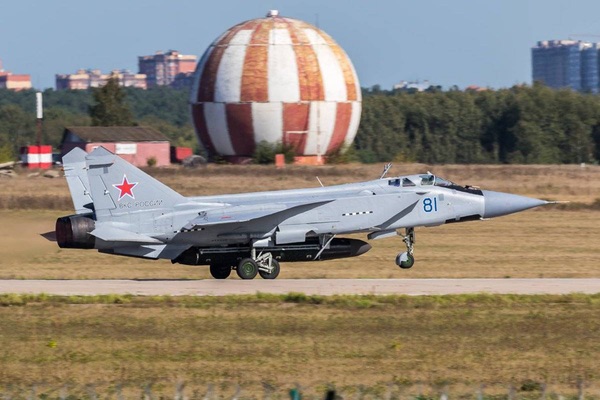 MiG-31BM nr. 81 taking off from Zhukovsky with the “293” rocket. (credit: Alex Snow) |
Other recently uncovered procurement documentation may provide conclusive evidence that the Burevestnik satellites are indeed ASAT interceptors. One contract (in Russian) for Burevestnik was signed in June 2017 between an organization called the Krasnoarmeysk Scientific Research Institute of Mechanization (KNIIM) and a company called OOO Expotekhvzryv. KNIIM is an institute in Krasnoarmeysk (a name derived from the Russian word for “Red Army”), which is situated about 60 kilometers northeast of Moscow. It is a leading manufacturer of ammunition and explosives, as can be seen in this profile of the institute.
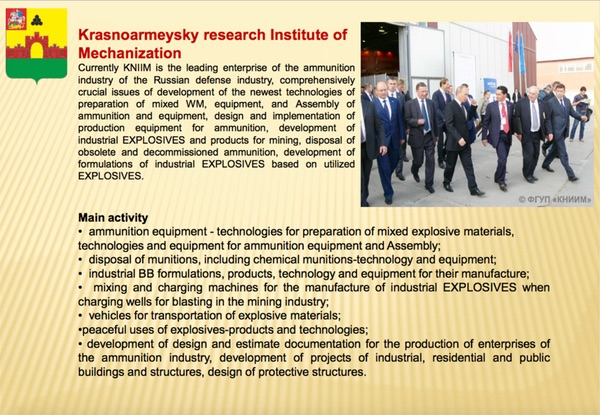 Profile of KNIIM. (credit: Krasnoarmeysk City District) |
Expotekhvzryv, based in Moscow, specializes in industrial safety control of “dangerous objects” (the word vzryv in the company’s name means “explosion”). Under the deal with KNIIM, it was to perform what was literally described as “industrial safety control of an experimental container for special products” and complete that work before the end of June 2017. According to the documentation, the work involved detonating the container to study the effects on its surroundings and on the container itself. The contract is clearly related to the Burevestnik-KA-M satellites because the documentation links the work to the December 2015 government contract that initiated that phase of the Burevestnik project and a subsequent one inked between CNIIHM and KNIIM on September 1, 2016.
The most logical interpretation of this information is that KNIIM developed some type of explosive charge for the Burevestnik satellites and that the tests conducted by Expotekhvzryv were needed to ensure that this material is safe for storage and transportation. While KNIIM seems to be the manufacturer of this payload, it should be noted that CNIIHM itself probably also has the necessary expertise in the field. Back in the 1960s and 1970s, a team at CNIIHM led by Kirill N. Shamshev devised two types of explosive charges that were carried by experimental interceptor satellites called IS (“Satellite Destroyer”). These were detonated when the satellites came in the vicinity of specially launched target satellites. According to its former website, CNIIHM has a “Center of Ammunition and Special Chemistry” and this may very well play a role in this work as well.
As is clear from several technical papers and patents, a number of Russian institutes (including CNIIHM) have also done research on non-destructive technology for co-orbital ASATs, mostly involving the use of finely dispersed particles that could presumably disable satellite sensors or cause other damage. Similar technology has also been studied to conceal satellites from potential enemy ASAT interceptors under a program known as Vual (see “Self-defense in space: protecting Russian spacecraft from ASAT attacks”, The Space Review, July 16, 2018). However, there are is no convincing proof that any of this work is connected to Burevestnik.
It is perfectly possible that Burevestnik satellites have already been tested in orbit. Between 2013 and 2019, Russia launched six mysterious satellites from the Plesetsk Cosmodrome that showed similar in-orbit behavior and transmitted on identical radio frequencies, indicating they share a common platform. They were called Kosmos-2491, 2499, 2504, 2521, 2535, 2536, and 2543. All were launched as co-passengers with other payloads, the first three on the Rockot launch vehicle (now retired) and the later ones on the Soyuz-2.1v, the lightest rocket in the Soyuz launch vehicle family (without the first-stage strap-on boosters and carrying NK-33 engines inherited from the Soviet-era N-1 moon rocket.) All except the first one performed rendezvous and proximity operations with other objects launched on the same mission, either the rocket’s upper stage or other satellites.
| It is perfectly possible that Burevestnik satellites have already been tested in orbit. |
Some of these satellites are likely part of a project called Nivelir, started in the same month as Burevestnik (September 2011) and also managed by CNIIHM. The Nivelir satellites are believed to be intended for on-orbit inspection of other satellites and are known to share at least two design features with the Burevestnik satellites, namely 4LI-20 lithium-ion batteries of PAO Saturn and MSKV84 fuel tanks of NIIMash, which likely feed K50-10.6 hydrazine monopropellant thrusters of OKB Fakel on both types of satellites. Because they seem to use a common bus, it is hard to tell which of the satellites belong to which program.
Two of the satellites (Kosmos-2521 and 2543) were deployed from larger “parent satellites” built by NPO Lavochkin (Kosmos-2519 and 2542). Having the military index 14F150, these are also part of the Nivelir project and themselves seem to be used for space situational awareness. Kosmos-2542 raised concern in US Defense Department circles earlier this year when it made several relatively close passes to the American reconnaissance satellite USA 245 in an apparent attempt to take detailed pictures of the satellite.
While most of the six satellites seem to have performed missions comparable to those of American and Chinese inspection satellites, two experiments conducted during these missions seem to have nothing to do with inspection. In October 2017, Kosmos-2521 itself deployed a small subsatellite (Kosmos-2523) that immediately lowered its perigee by 100 kilometers and has remained inert ever since without ever coming close to another satellite. Speaking to Time magazine last February, Gen. John Raymond, the commander of the U.S. Space Force, likened these satellites to Russian nesting dolls and described the subsatellite as a “high-speed projectile.” Possibly, Kosmos-2523 was another top-secret satellite of CNIIHM identified as Napryazheniye, the purpose of which is unclear.
Another puzzling event occurred last year during the mission of Kosmos-2535 and 2536, launched in July 2019 along with two other satellites (Kosmos-2537 and 2538) that are probably used for calibration of ground-based radars. About two weeks after launch, Kosmos-2535 and 2536 began a lengthy series of close encounters that continued until earlier this year. The first of those, in early August, was actually reported by the Russian Ministry of Defense, which described the two objects as an “inspection satellite” and a “registering satellite.” They were reportedly on a mission to study the effects of “artificial and natural space factors” on satellites and also to test technology to protect satellites and service them in orbit. More specifically, the equipment on the inspector satellite was designed to study the effects on the registering satellite of “space debris, electron and proton radiation of the Earth’s outer natural radiation belt, protons and heavy charged particles, solar and galactic cosmic rays.”
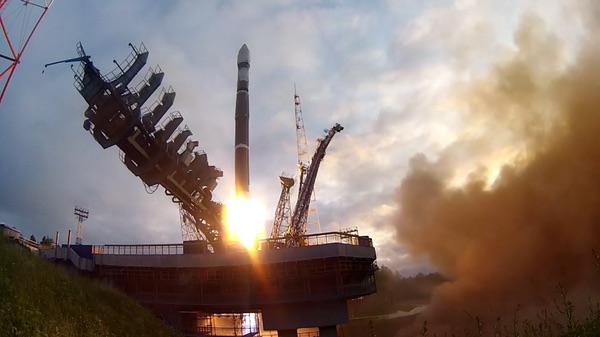 Launch of Kosmos-2535/2536/2537/2538 by a Soyuz-2.1v rocket on July 10, 2019. |
Then, in mid-October, objects labeled as “Kosmos-2535 debris” started gradually appearing in the catalog of space objects maintained by the United States Strategic Command. In all, 24 such objects were registered. The catalog does not disclose when exactly the satellite generated this debris, but orbital analysis has traced most of it back to a close encounter between Kosmos-2535 and 2536 in late September (which would mean the debris could have come from either satellite).
| If Burevestnik has already been tested in orbit, it was launched as a co-passenger on a conventional ground-based rocket. However, this is likely to change in the future. |
The debris wound up in widely scattered orbits with altitudes ranging from less than 400 to more than 1,000 kilometers, while the two satellites themselves have been circling the Earth in roughly circular orbits slightly over 600 kilometers above the Earth. This means it must have been created by some sort of energetic event. Both of the satellites did continue maneuvering afterwards, meaning that neither was rendered inoperable.
This could lead one to conclude that it was either a failed ASAT test or not an ASAT test at all. However, numerous other scenarios are possible as well, including one where the Russians elected to test an explosive charge without destroying the satellites in order to minimize the amount of debris and not attract undue attention to the mission. It could, for instance, have been ejected in a canister and detonated at a safe distance, with one or both of the satellites observing the event. It is also possible that one or both satellites carried protective material enabling them to survive the event and even sensors to detect possible impacts, like many of the target satellites used in the Soviet IS project. Such scenarios would still be in line with two of the mission objectives given in the official Russian statement on the mission, namely studying the effects of space debris and testing technology to protect satellites in orbit.
If Burevestnik has already been tested in orbit, it was launched as a co-passenger on a conventional ground-based rocket. However, this is likely to change in the future. As is clear from the evidence presented above, the satellites, the “293” rocket, and the MiG-31BM aircraft are part of one and the same project. Most likely, the air-launched “293” rocket will serve as a launch vehicle for future Burevestnik satellites. In Russian terminology, all these components would be described as belonging to the same “space complex,” a word used for the combination of the satellites, the launch vehicle, and all the ground-based infrastructure needed to support them. In some official documents, Burevestnik has been more specifically called “a space security complex,” a fitting term for an ASAT project (it has also been applied in one document to a project called Kalina, a ground-based laser system designed to blind or dazzle optical instruments of satellites). The index for the Burevestnik space complex is 14K168.
The idea that “293” is a satellite launch vehicle is corroborated by the fact that the index for one of its stages (14S47) is similar to that of some upper stages of space launch vehicles. Moreover, plans to use the MiG-31 as a satellite launch platform are not new. They were first put forward by the MiG design bureau in the late 1990s and culminated in a 2005 Russian/Kazakh proposal called Ishim to equip the aircraft with a three-stage solid-fuel rocket capable of placing 160-kilogram satellites into 300-kilometer orbits with a 46-degree inclination. With a maximum speed of Mach 2.8 and a service ceiling of more than 20 kilometers, the MiG-31 is an ideal platform for such missions.
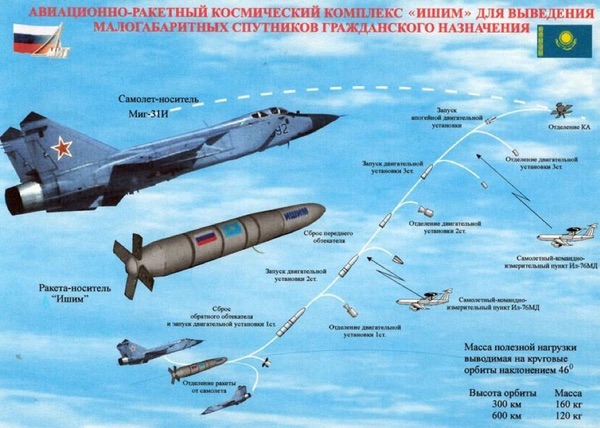 Diagram showing an Ishim rocket flying to space from a MiG-31 aircraft. |
With the Burevestnik satellites probably weighing around 100 kilograms or less, a rocket the size of “293” should be capable of placing them into orbit from a MiG-31, although potential targets would probably be limited to satellites in relatively low orbits, primarily reconnaissance satellites. The use of an air-launched rocket instead of a ground-based launch vehicle offers several advantages for ASAT missions. First, not being tied to a specific launch site, air-launched rockets can use a much broader variety of launch azimuths and, consequently, send satellites into a wide range of orbital inclinations. Second, they can be prepared for launch at short notice (certainly solid-fuel rockets like “293”) and away from the prying eyes of reconnaissance satellites, giving the enemy little warning time. By contrast, the Soyuz-2.1v, the lightest launch vehicle in Russia’s current rocket fleet, is a liquid-fuel launch vehicle that needs two days of launch preparations on a single available pad. In addition to that, the Soyuz-2.1v (with a payload capacity of 2.8 tons to low Earth orbit) would be far oversized for launching a single Burevestnik satellite. Both the “293” rocket and its apparent successor (“328”) could potentially also be used to launch other small military satellites on quick-response missions, a capability that the US military has been seeking for a long time without much success.
| All the construction work is a sign that Burevestnik is not merely seen as an experimental system, but one that Russia intends to place on operational stand-by. When that will occur is hard to tell. |
All this does raise the question why dedicated infrastructure for Burevestnik is being built at the Plesetsk Cosmodrome. This infrastructure is identified in procurement documents as “Object 7511/4,” As can be inferred from recent procurement documents, a new contract for the construction work was awarded by the Ministry of Defense just last December, clearly showing it is not yet finished. One possible explanation is that Burevestnik flights using the MiG-31BM will be staged from Plesetsk’s airfield (known as “Pero”), benefiting from the cosmodrome’s infrastructure for storage and preparation of rockets and satellites. Another, much more remote possibility is that “293” has a two-stage air-launched version (consisting of the 14D813 and 14S47 stages) that can take off from a multitude of air bases and a three-stage ground-launched version (consisting of the 14D812, 14D813, and 14S47 stages) that will be based at Plesetsk. It is hard to tell whether the rocket seen in the photos taken at Zhukovsky has two or three stages. Similarly, America’s Pegasus air-launched rocket had a ground-based “sister rocket” (Taurus/Minotaur-C), which essentially consisted of a Pegasus mounted on top of the first stage of a Peacekeeper ICBM. However, there are no clear signs that any launch infrastructure for such a rocket is being built at Plesetsk.
Other ground-based infrastructure for Burevestnik, named “Object 7511/3,” is under construction near Pervomayskoye in the Tambov province, about 450 kilometers southeast of Moscow. This is the location of a military base (nr. 14272) primarily used for the long-term storage of rockets awaiting shipment to the launch site.
The control center for Burevestnik missions is likely situated right next to the headquarters of Russia’s space surveillance network in Noginsk-9 (also known as Dubrovo), a small town about 60 kilometers east of Moscow. Noginsk-9 was also home to the control center for the Soviet-era co-orbital ASAT missions. A facility in Noginsk-9 known as “Object 3006M” has been linked in building contracts to both Burevestnik and Nivelir. It will probably be fed with targeting data by a network of space surveillance radars and optical telescopes stationed across Russia. Autonomous satellite navigation equipment known to have been developed for Burevestnik satellites by MKB Kompas should also help guide the satellites to their targets relatively quickly. Even with 1970s technology, the Soviet-era IS interceptor satellites demonstrated the ability to reach their targets on the first orbit after launch.
All the construction work is a sign that Burevestnik is not merely seen as an experimental system, but one that Russia intends to place on operational stand-by. When that will occur is hard to tell. The Burevestnik project has been underway for almost a decade but, like many other Russian space projects, was probably hit hard by the Western-imposed sanctions that complicated the delivery of foreign-built electronic components for the Russian space industry. Despite Russia’s policy of “import substitution,” even highly classified Russian military satellites remain very reliant on Western electronics. This is illustrated by one 2016 contract for the delivery of electronic components for Burevestnik satellites, which listed a total of 457 foreign electronic components versus just 45 Russian-built components.
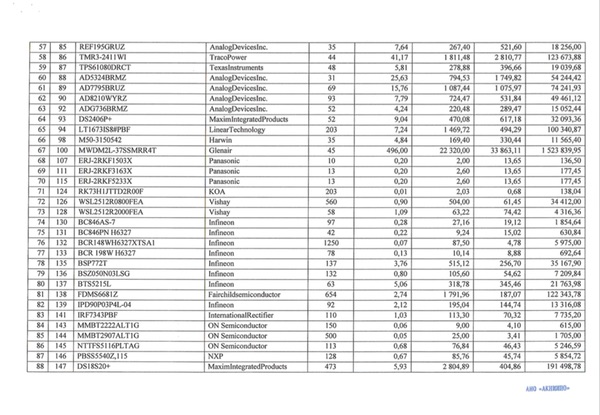 Some of more than 400 Western-built electronic components ordered for Burevestnik satellites by one company in 2016. Source |
Still, it does look like one or more Burevestnik satellites have already been tested in space, with more such test flights (using the Soyuz-2.1v) possibly yet to come. As for the “293” rocket, the one seen in the September 2018 photos was presumably a mock-up, but one of the earlier quoted RKS MiG contracts signed in August 2019 strongly suggests that a “live” version is undergoing captive carry tests by now. A CNBC article published in September 2018 quoted “three sources with direct knowledge of a U.S. intelligence report” as saying that the MiG-31BM spotted shortly before was believed to be “a mock-up of an anti-satellite weapon that will be ready for warfare by 2022.”
As large in scope as Burevestnik appears to be, it is only one of several ASAT projects that Russia is currently working on. The most advanced of these is Nudol, a ground-launched direct-ascent ASAT missile built by OKB Novator that is believed to have made at least ten test flights from Plesetsk since 2014, without destroying targets in space. The latest of these took place on April 15, prompting an immediate response from the US Space Command’s Gen. John Raymond, who regards it as “further proof of Russia’s hypocritical advocacy of outer space arms control proposals designed to restrict the capabilities of the United States while clearly having no intention of halting their counterspace weapons programs.” Recently gathered evidence indicates that another, possibly more capable missile may be under development for Nudol at the Moscow-based MIT Corporation.
| The co-existence of several ASAT projects indicates they are designed to fulfill complementary roles, possibly targeting different types of satellites in different types of orbits. |
Other likely ASAT systems under development are ground-based and air-based systems to dazzle or blind satellite optical systems (Kalina and Sokol-Eshelon) and ground-based and space-based systems for electronic warfare (Tirada-2S and Ekipazh). In November 2017, a Russian military official also disclosed the existence of a “mobile anti-satellite complex” called Rudolf, about which nothing is known. Another satellite under development at CNIIHM called Numizmat will probably carry a hard-to-detect ultrawide-band noise radar for proximity operations and may also have an ASAT-related role. An up-to-date overview of Russian ASAT systems is given in the latest edition of the Secure World Foundation’s annual report Global Counterspace Capabilities: An Open-Source Assessment.
The co-existence of several ASAT projects indicates they are designed to fulfill complementary roles, possibly targeting different types of satellites in different types of orbits. Similarly, in the 1980s the Soviet Union worked on a plethora of ASAT systems, each of which had its own well-defined tasks in various possible war scenarios. The collapse of the Soviet Union prevented any of those from reaching operational status, but by all indications Russia now once again has a sustained program to develop a broad range of counterspace capabilities, whatever the motives for that may be.
For more details on Burevestnik and a complete list of sources, see this thread on the NASA Spaceflight Forum, which is updated with new information as it becomes available.
Note: we are temporarily moderating all comments submitted to deal with a surge in spam.